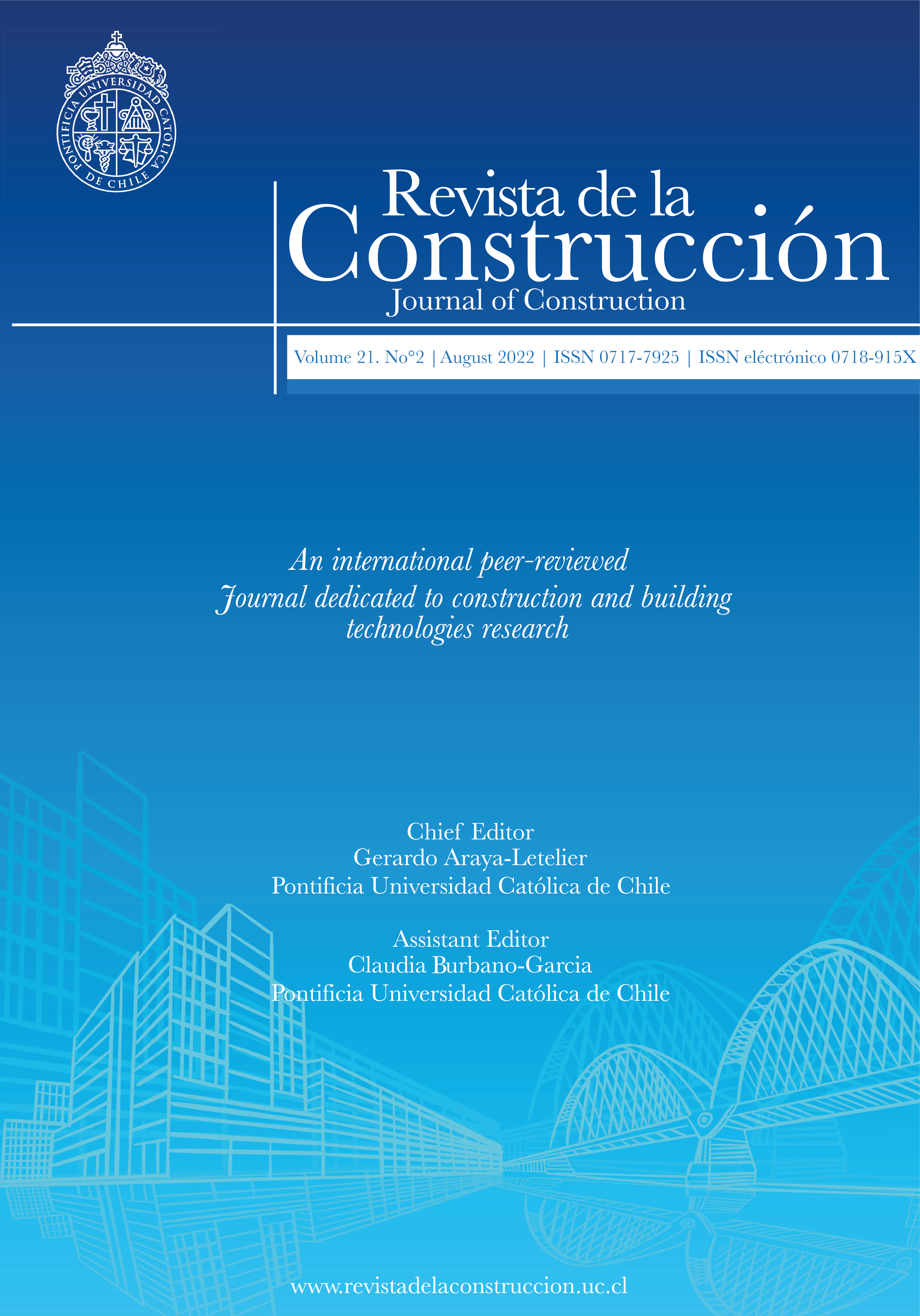Torsional performance of reinforced concrete beam with carbon fiber and aramid fiber laminates
DOI:
https://doi.org/10.7764/RDLC.21.2.329Keywords:
Carbon fiber, Aramid fiber, retrofitting, torsional analysis, ANSYSAbstract
In the presented research paper, investigated the torsional performance of reinforced concrete beams with light emissions grade of cement utilizing Carbon fiber and its relative investigation with aramid fiber, for its torsional conduct, utilizing both exploratory and insightful strategies. A distinctive example of its strips folded over RC beams and the torsional conduct of these restrengthened beams is considered. Carbon fiber (CF) is utilized as outside support. Reinforced concrete beam retrofitted with CF tried for torsional disappointment utilizing lever arms exposed to torque. The beams have dimensions of 150mm in width and 200mm in depth and 1 m long, as planned according to IS456-2000. Three bars are intended for a twist. Steel has a stronger ultimate strength but a lower density than aramid FRP, as well as being easier to install and requiring no interim support until it reaches its full strength. The impact of various sorts and designs of CF on the initial stage of breaking load, extreme load conveying limit, and disappointment method of the beam are thought about and its relative examination utilizing finite element programming with aramid fiber gives a better outcome for additional investigation.
Downloads
References
Abed, F., El-Chabib, H., & AlHamaydeh, M. (2012). Shear characteristics of GFRP-reinforced concrete deep beams without web reinforce-ment. Journal of Reinforced Plastics and Composites, 31(16), 1063–1073. doi:10.1177/0731684412450350
Al-Mahmoud, F., Castel, A., & François, R. (2013). Modeling of flexural behaviour of RC beams strengthened with NSM CFRP rods including serviceability. European Journal of Environmental and Civil Engineering, 17(7), 532–553. doi:10.1080/19648189.2013.797926
Amer M. Ibrahim, & Amer M. Ibrahim. (2009). Finite Element Modeling of Reinforced Concrete Beams Strengthened with FRP Laminates. European Journal of Scientific Research, 30(4), 526–541.
Anadee M. Kulkarni, & Debarati Datta. (2019). Probabilistic analysis of RC beams according to IS456:2000 in limit state of collapse. Struc-tural Engineering and Mechanics, 71(2), 165–173.
Askandar, N. H., Mahmood, A. D., & Kurda, R. (2020). Behaviour of RC beams strengthened with FRP strips under combined action of torsion and bending. European Journal of Environmental and Civil Engineering, 1–17. doi:10.1080/19648189.2020.1847690
Banjara, N. K., & Ramanjaneyulu, K. (2017). Experimental and numerical investigations on the performance evaluation of shear deficient and GFRP strengthened reinforced concrete beams. Construction and Building Materials, 137, 520–534. doi: 10.1016/j.conbuildmat.2017.01.089
Chen, J. F., & Teng, J. G. (2003). Shear capacity of FRP-strengthened RC beams: FRP debonding. Construction and Building Materials, 17(1), 27–41. doi:10.1016/S0950-0618(02)00091-0
Islam, M. R., Mansur, M. A., & Maalej, M. (2005). Shear strengthening of RC deep beams using externally bonded FRP systems. Cement and Concrete Composites, 27(3), 413–420. doi: 10.1016/j.cemconcomp.2004.04.002
Kilic, I., & Gokce Gok, S. (2021). Strength and durability of roller compacted concrete with different types and addition rates of polypropyl-ene fibers. Revista de La Construcción, 20(2), 205–214. doi:10.7764/RDLC.20.2.205
Mohammadizadeh, M. R., Fadaee, M. J., & Ronagh, H. R. (2009). Improving Torsional Behaviour of Reinforced Concrete Beams Strengthened with Carbon Fibre Reinforced Polymer Composite. Iranian Polymer Journal (Vol. 18).
More, R. U., & Kulkarni, D. B. (2014). Flexural behavioral study on RC beam with externally bonded aramid fiber reinforced polymer. Inter-national Journal of Research in Engineering and Technology, 3(7), 316–321.
Mostofinejad, D., Tabatabaei Kashani, A., & Hosseini, A. (2016). Design model for shear capacity of RC beams strengthened with two-side CFRP wraps based on effective FRP strain concept. European Journal of Environmental and Civil Engineering, 20(2), 161–179. doi:10.1080/19648189.2015.1021382
Nabil F. Grace, George Abdel-Sayed, & Wael F. Ragheb. (2002). Strengthening of Concrete Beams Using Innovative Ductile Fiber-Reinforced Polymer Fabric. ACI Structural Journal, 692–700.
Pellegrino, C., & Modena, C. (2006). Fiber-reinforced polymer shear strengthening of reinforced concrete beams: Experimental study and analytical modeling. ACI Structural Journal, 103(5), 720–728.
Rooholamini, H., Hassani, A., & Aliha, M. R. M. (2018). Fracture properties of hybrid fiber-reinforced roller-compacted concrete in mode I with consideration of possible kinked crack. Construction and Building Materials, 187, 248–256. doi: 10.1016/j.conbuildmat.2018.07.177
Sethuraman Muthusamy Kavith, G. Venkatesan, Siva Avudaiappan, & Erick I. Saavedra Flores. (2020). Mechanical and flexural performance of self-compacting concrete with natural fiber. Revista de La Construcción, 19(2), 370–380.
SIDDIQUI, N. A. (2010). Experimental investigation of RC beams strengthened with externally bonded FRP composites. Latin American Journal of Solids and Structures, 6(4), 343–362.
Sundarraja, M. C., & Rajamohan, S. (2009). Strengthening of RC beams in shear using GFRP inclined strips – An experimental study. Con-struction and Building Materials, 23(2), 856–864. doi: 10.1016/j.conbuildmat.2008.04.008
Downloads
Published
How to Cite
Issue
Section
License
Copyright (c) 2022 S. Shanmugasundaram , R. Mohanraj, S. Senthilkumar, P. Padmapoorani

This work is licensed under a Creative Commons Attribution-NonCommercial-NoDerivatives 4.0 International License.








